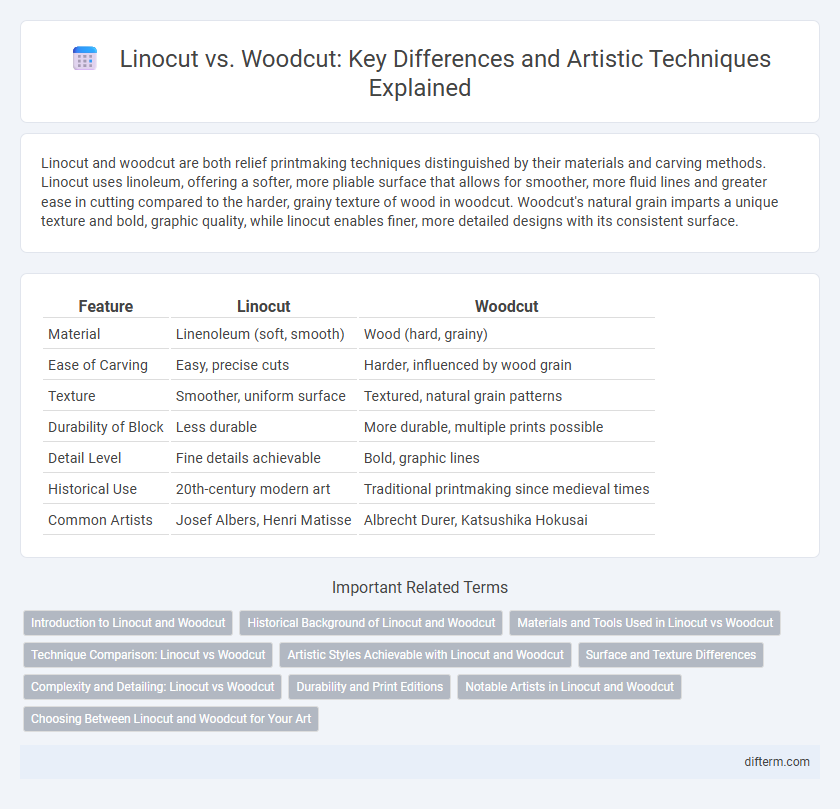Linocut and woodcut are both relief printmaking techniques distinguished by their materials and carving methods. Linocut uses linoleum, offering a softer, more pliable surface that allows for smoother, more fluid lines and greater ease in cutting compared to the harder, grainy texture of wood in woodcut. Woodcut's natural grain imparts a unique texture and bold, graphic quality, while linocut enables finer, more detailed designs with its consistent surface.
Table of Comparison
| Feature | Linocut | Woodcut |
|---|---|---|
| Material | Linenoleum (soft, smooth) | Wood (hard, grainy) |
| Ease of Carving | Easy, precise cuts | Harder, influenced by wood grain |
| Texture | Smoother, uniform surface | Textured, natural grain patterns |
| Durability of Block | Less durable | More durable, multiple prints possible |
| Detail Level | Fine details achievable | Bold, graphic lines |
| Historical Use | 20th-century modern art | Traditional printmaking since medieval times |
| Common Artists | Josef Albers, Henri Matisse | Albrecht Durer, Katsushika Hokusai |
Introduction to Linocut and Woodcut
Linocut and woodcut are traditional printmaking techniques that use relief printing, where raised areas of a carved surface are inked and pressed onto paper. Linocut employs linoleum as a softer, more uniform material, allowing for smoother cuts and finer details, while woodcut uses wood blocks with pronounced grain that influences texture and line quality. Both methods offer distinct aesthetic qualities, with linocut favoring bold, clean shapes and woodcut delivering more organic, textured impressions.
Historical Background of Linocut and Woodcut
Woodcut art dates back to the early 9th century in China, becoming a dominant printmaking technique in Europe during the 15th century for producing religious and literary texts. Linocut emerged in the early 20th century, popularized by artists like Pablo Picasso and Henri Matisse, offering a modern alternative using softer, easier-to-carve linoleum surfaces. Both techniques revolutionized printmaking by enabling mass production of artworks while showcasing distinct textures and stylistic possibilities inherent to their materials.
Materials and Tools Used in Linocut vs Woodcut
Linocut utilizes linoleum blocks as the primary material, which is softer and easier to carve compared to the hardwood used in woodcut, typically made from cherry or pear wood. Tools for linocut include special gouges and knives designed to cut through the smooth, pliable linoleum, whereas woodcut requires stronger, durable chisels and knives to handle the dense grain and toughness of wood. The choice of material and tools directly influences the texture and detail achievable in each printmaking technique, with linocut allowing for smoother lines and woodcut offering more pronounced grain effects.
Technique Comparison: Linocut vs Woodcut
Linocut technique involves carving into a soft, smooth linoleum surface, allowing for precise, clean lines and fine details, while woodcut requires cutting into a harder wooden block, resulting in a more textured and bold impression. Linocut tools such as gouges create consistent depths and smooth curves, whereas woodcut knives often produce varied textures due to the grain of the wood. The ease of carving linoleum makes it ideal for intricate designs, whereas woodcuts emphasize strong contrasts and rugged aesthetics inherent to the wood's natural surface.
Artistic Styles Achievable with Linocut and Woodcut
Linocut offers bold, clean lines and smoother textures, ideal for contemporary and graphic styles with sharp contrasts and minimal detail. Woodcut produces rich, textured effects with visible grain, lending itself to expressive, intricate designs and traditional or rustic aesthetics. Both techniques enable unique artistic expression but differ in surface detail and line quality, influencing the overall mood and style of the artwork.
Surface and Texture Differences
Linocut surfaces are smoother and more uniform, allowing for cleaner, sharper lines and finer details compared to woodcut's naturally grained surface. Woodcut textures reveal the wood's grain and knots, creating a more organic and varied impression that adds depth and character to the print. The softness of linoleum permits easier carving and subtler textural effects, while wood's hardness results in bolder, more rugged textures.
Complexity and Detailing: Linocut vs Woodcut
Linocut offers smoother carved lines with less resistance, enabling artists to achieve intricate details and fine textures more easily compared to woodcut. Woodcut's natural wood grain texture adds complexity but can limit precision and delicate detailing. Both techniques yield distinctive artistic results, but linocut excels in detailed, complex imagery while woodcut emphasizes bold, textured designs.
Durability and Print Editions
Linocut blocks, made from softer linoleum, wear down faster than traditional woodcut blocks, limiting the number of high-quality prints in an edition. Woodcut blocks, carved from hard wood like cherry or maple, offer greater durability, enabling artists to produce larger print editions without significant loss of detail. This durability difference makes woodcut preferable for extensive print runs, while linocut suits shorter, more experimental editions.
Notable Artists in Linocut and Woodcut
Notable artists in linocut include Pablo Picasso, who explored this medium for its bold textures and dynamic contrasts, and Elizabeth Catlett, known for her powerful social and political themes. In woodcut, Albrecht Durer stands out as a master of intricate detail and innovation during the Renaissance, while Hokusai's iconic Japanese prints highlight the precision and flowing lines possible in this technique. Both linocut and woodcut have influenced modern printmakers such as S.W. Hayter and Edvard Munch, who pushed the boundaries of expression within relief printing.
Choosing Between Linocut and Woodcut for Your Art
Choosing between linocut and woodcut depends on the desired texture and detail in your artwork; linocuts offer smoother lines and are easier to carve, making them ideal for beginners and intricate designs. Woodcuts provide a more textured, traditional look with rich grain patterns, suitable for bold, expressive prints. Consider the durability of tools and materials, as linoleum is softer and wears faster, while wood is harder but demands more carving skill and time.
Linocut vs Woodcut Infographic

 difterm.com
difterm.com